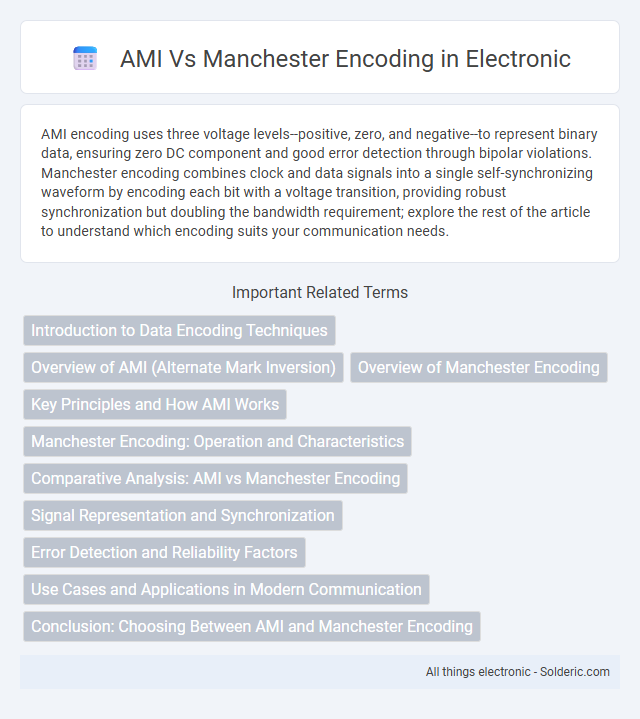AMI encoding uses three voltage levels--positive, zero, and negative--to represent binary data, ensuring zero DC component and good error detection through bipolar violations. Manchester encoding combines clock and data signals into a single self-synchronizing waveform by encoding each bit with a voltage transition, providing robust synchronization but doubling the bandwidth requirement; explore the rest of the article to understand which encoding suits your communication needs.
Comparison Table
| Feature | AMI Encoding | Manchester Encoding |
|---|---|---|
| Definition | Alternate Mark Inversion uses alternating polarity for logic '1' | Manchester encoding combines clock and data signals via mid-bit transitions |
| Signal Polarity | Alternates positive and negative pulses for consecutive '1's | Transitions at mid-bit: low-to-high represents '1', high-to-low represents '0' |
| Bandwidth Efficiency | Higher; requires less bandwidth due to less frequent transitions | Lower; doubles the baud rate, increasing bandwidth requirement |
| Clock Recovery | Less reliable without long sequences of zeros | Self-clocking due to guaranteed transitions per bit |
| DC Component | Zero DC component due to alternating marks | No DC component; balanced signal with equal high and low durations |
| Use Case | Telecommunications, T1 lines | Ethernet, RFID, digital communication requiring synchronization |
Introduction to Data Encoding Techniques
AMI encoding uses three voltage levels--positive, zero, and negative--to represent binary data, improving error detection through bipolar violation signals. Manchester encoding combines clock and data signals into a single self-synchronizing format, where each bit period contains a transition, enhancing timing accuracy. Both techniques optimize data transmission reliability but differ in complexity, bandwidth requirements, and synchronization properties.
Overview of AMI (Alternate Mark Inversion)
AMI (Alternate Mark Inversion) encoding uses three voltage levels: positive, negative, and zero, where logical '1's are represented by alternating positive and negative pulses, and '0's are denoted by zero voltage. This bipolar signaling technique reduces the DC component and improves error detection in digital communication systems. AMI encoding is widely used in T1 carrier systems and other telecommunications applications due to its efficient bandwidth utilization and robustness against baseline wander.
Overview of Manchester Encoding
Manchester encoding represents digital data through voltage level transitions, combining clock and data signals into a single self-synchronizing stream. Each bit period contains a transition at the midpoint: a low-to-high transition denotes a binary '0', while a high-to-low transition signifies a binary '1'. This encoding method simplifies clock recovery and reduces synchronization errors compared to Alternate Mark Inversion (AMI) by ensuring a consistent signal transition for every bit.
Key Principles and How AMI Works
Alternate Mark Inversion (AMI) encoding uses three voltage levels: positive, zero, and negative, representing binary data by alternating polarity for each logical '1' while '0's remain at zero voltage. Manchester encoding combines clock and data signals by encoding each bit with a voltage transition at the midpoint, ensuring synchronization without extra clock signals. AMI's key advantage is reducing DC bias and enabling error detection through bipolar violations, making it efficient for telecommunication systems requiring long-distance transmission.
Manchester Encoding: Operation and Characteristics
Manchester encoding operates by combining clock and data signals into a single self-synchronizing data stream where each bit period is divided into two equal intervals; a logical "1" is represented by a high-to-low transition, and a logical "0" by a low-to-high transition. This encoding method eliminates the need for a separate clock signal, enabling reliable data recovery even in the presence of timing variations. Characteristics include a constant DC balance, robust synchronization, and a doubled bandwidth requirement compared to non-return-to-zero (NRZ) encoding.
Comparative Analysis: AMI vs Manchester Encoding
AMI encoding transmits data using three voltage levels, enabling efficient bandwidth usage and better error detection with bipolar violations, while Manchester encoding combines clock and data signals into a single self-synchronizing stream, improving timing reliability but doubling the required bandwidth. AMI is advantageous for long-distance communication due to its simpler signal spectrum and compatibility with existing infrastructure, whereas Manchester encoding excels in environments demanding precise synchronization, like Ethernet networks. Your choice depends on whether bandwidth efficiency or synchronization robustness is prioritized for the specific communication system.
Signal Representation and Synchronization
AMI (Alternate Mark Inversion) encoding represents binary data with three voltage levels: positive, negative, and zero, aiding in error detection through polarity alternation. Manchester encoding combines clock and data signals by encoding bits with transitions, ensuring inherent synchronization without the need for a separate clock signal. Your choice between AMI and Manchester encoding impacts signal integrity and timing accuracy in digital communication systems.
Error Detection and Reliability Factors
AMI encoding inherently supports error detection by recognizing bipolar violations that signal transmission errors, enhancing reliability in noisy environments. Manchester encoding offers built-in clock synchronization and robustness against timing errors, which improves data integrity across varying channel conditions. Both encoding schemes contribute to reliable communication by balancing error detection capabilities with signal clarity, but Manchester encoding typically provides better synchronization at the cost of increased bandwidth.
Use Cases and Applications in Modern Communication
AMI encoding is widely used in T1 and E1 digital transmission systems due to its ability to maintain synchronization without a DC component, making it ideal for long-distance telephony and data communication. Manchester encoding is preferred in Ethernet and RFID systems because it ensures clock recovery by embedding the clock signal within the data, enhancing data integrity over shorter distances. Your choice depends on whether the application prioritizes synchronization over long-haul transmission (AMI) or precise timing in local area networks and digital communication devices (Manchester).
Conclusion: Choosing Between AMI and Manchester Encoding
Choosing between AMI and Manchester encoding depends on your specific communication needs such as bandwidth efficiency, synchronization requirements, and error detection capabilities. AMI offers better bandwidth efficiency with no DC component, making it suitable for longer distances, while Manchester encoding provides inherent clock synchronization and improved error detection at the expense of doubling the signal rate. Your decision should balance these factors to optimize data integrity and transmission performance in your network.
AMI vs Manchester encoding Infographic

 solderic.com
solderic.com